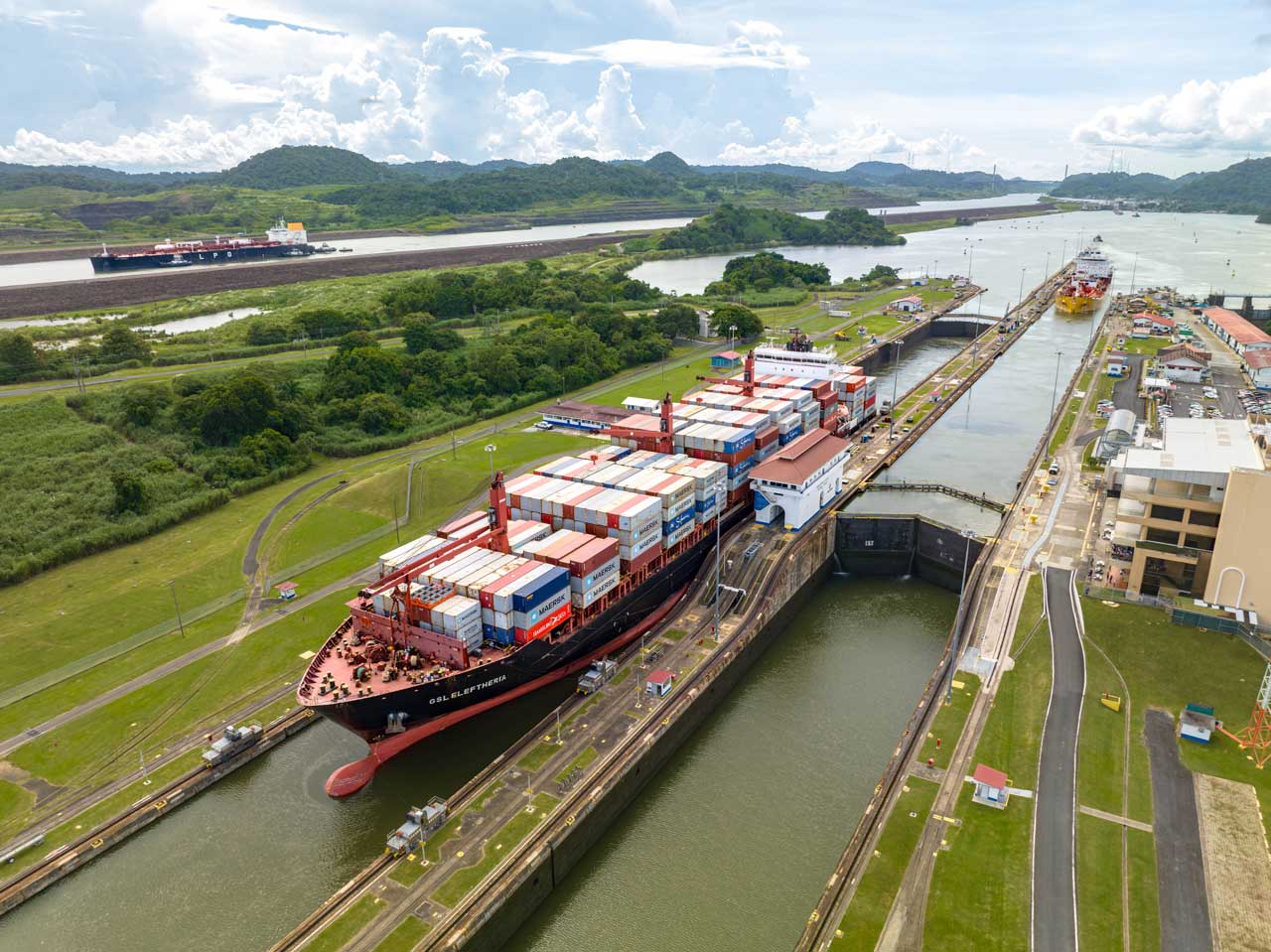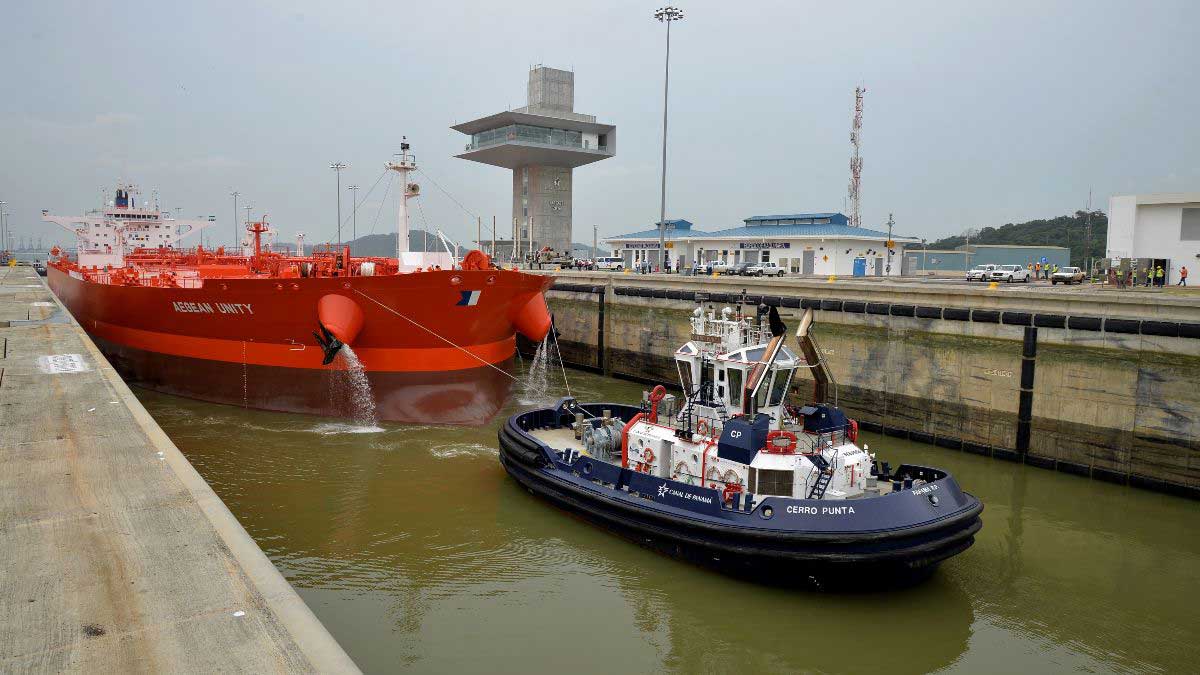Panamá, August 10, 2001 – The Panama Canal Modernization and Improvement Program includes, among its most important components, the widening of Gaillard Cut, the modernization of the locks machinery and its controls, the procurement of new tugboats and locomotives, the rehabilitation of the tow tracks, the modernization of computer systems, and the improvement of the telecommunications network.
The Gaillard Cut Program includes its widening from 152 meters, to a minimum of 192 meters along straight stretches, and a maximum of 222 meters along curves. This will allow simultaneous two-way traffic of wide-beam Panamax vessels, without compromising navigational safety in Canal waters. On July 4, 2001, the last blasting operation of the cut-widening program was performed, thus achieving 100% completion of the drilling and open-air blasting program. At present, the dry excavation has been totally concluded, and the wet excavation is 99 percent complete. In regards to volume, the total widening project is 97 percent complete. The dredging portion of the project has been scheduled for completion by the end of December, even though the current signaling at the Cut will continue during four additional months, before making full use of the widening.
The modernization of equipment and controls at the locks are in progress at full speed. With the incorporation of new control technologies to the new hydraulic equipment and the existing mechanisms, a safer and more reliable operation will be achieved, by the use of strong electronic controllers, optic fiber, and computerized tools. It is expected that by December 2001, testing of the prototype of a control panel with flat screen monitors will take place at the Pedro Miguel Locks Control House. There will also be diagnosis, statistics, and remote audit stations to be used simultaneously in the maintenance of all locks equipment. With the success of the prototype, by September 2002, this technology will also be used at the other locks. To date, the electro-mechanic machinery of 54 miter gates has been converted to the hydraulic system, and 26 remain to be installed. In addition, two hydraulic laboratories with miter gate hydraulic machinery were built for use in testing, rehearsals, and staff training.
At the conclusion of this project in September 2002, the total number of converted machinery will be 80 miter gates in operation. At the same time, the purchase of the first 18 sets of hydraulic machinery to replace the 116 electro-mechanic rising stem valves will begin in 2002. Subsequently, in the year 2003, the 12 strut arms of the vehicular bridge gates and the 20 rising stem valves hydraulic machinery of the Panama Canal locks will also be converted.
Another component of the program, the acquisition of seven additional tugs, will augment the fleet to 24 tugs. In 1996, the Canal had a fleet of 17 tugs. In 1997, two tugs were added, the Gilberto Guardia F. and the Cecil Haynes. In 1998, the tug Cacique joined the fleet.
In September 2000, a bid was opened for the purchase of two additional units. Of these two, the Colon will arrive in Panama in late August, and the Cocle is expected for delivery by the end of September. On July 3rd of this year, the order was given to proceed with the construction of two additional tugs, thus reaching the goal of a fleet comprised of 24 units by fiscal year 2002.
The project for the addition of new locomotives consists of the purchase of 26 locomotives. Eight prototypes of a new generation of locomotives were received at the end of 1999 and in June 2000. After several modifications proposed by the ACP to the manufacturers, the order to proceed was given for the construction of the remaining 18 locomotives.
These new, third generation, locomotives, operate with two 290 horsepower traction units and are capable of towing at a speed of eight kilometers per hour, which is almost twice as much as the capacity of the current locomotives. The first eight of the 18 units ordered will arrive in Miraflores at the end of September. The remaining 10 are scheduled to arrive in April 2002. The total replacement of the fleet with the new type of locomotives has also been approved.
The objective of the tow tracks rehabilitation project is to remove and replace the tracks and the racks on which the locomotives operate, with a more structurally strong system that may support the loads exerted on them by the new locomotives, in response to the present and future demands of force and tolerance. This is due to the fact that the transit of Panamax vessels requires the locomotives to have greater power and speed, and these, in turn, produce greater wear on the tracks and racks. This project began in Miraflores in fiscal year 1997, with a 24.38-meter prototype. As of July 20, 2001, 2,020.21 meters of tracks had been rehabilitated in Gatun Locks, 2,227.78 meters at the Pedro Miguel Locks, and 1,883.05 meters at the Miraflores Locks, representing 37.88 per cent execution of the project.
With regard to the advances in the modernization projects of the information systems, the Canal Traffic Control System was replaced by the Enhanced Traffic Management System (EVTMS) and it was improved by the addition of the capacity for tracking ships in Canal waters as an aid to navigation and maritime traffic control; the financial subsystems by the financial management electronic platform ORACLE; and the Human Resources, Timekeeping, and Payroll systems will be replaced this year by ORACLE modules integrated to the financial system.
Furthermore, the Geographic Information System was developed for the administration of the Canal’s patrimony, and this year the first phase of the Managerial Decisions Support System will be completed. This is a managerial information system that will provide integrated financial and operational information to analyze the historic behavior and make forecasts of the different services offered by the Canal.
Another important part of the Panama Canal modernization and improvement program are the improvements to the telecommunications network.
The rehabilitation of the trans-isthmian duct system, scheduled for completion in September 2001, along with the acquisition and installation of an optic fiber cable, will strengthen the underground infrastructure of the Canal’s telecommunications network.
These projects, with an estimated value of US$7.9 million, will provide the Canal sufficient transmission speed and bandwidth to integrate video, voice, and data services throughout the main installations of the Canal, from the Pacific to the Atlantic.
This investment program will allow the ACP to continue satisfying safely and efficiently the expected mid-term demand for traffic, thus offering greater benefits to Canal users and the Republic of Panama.




